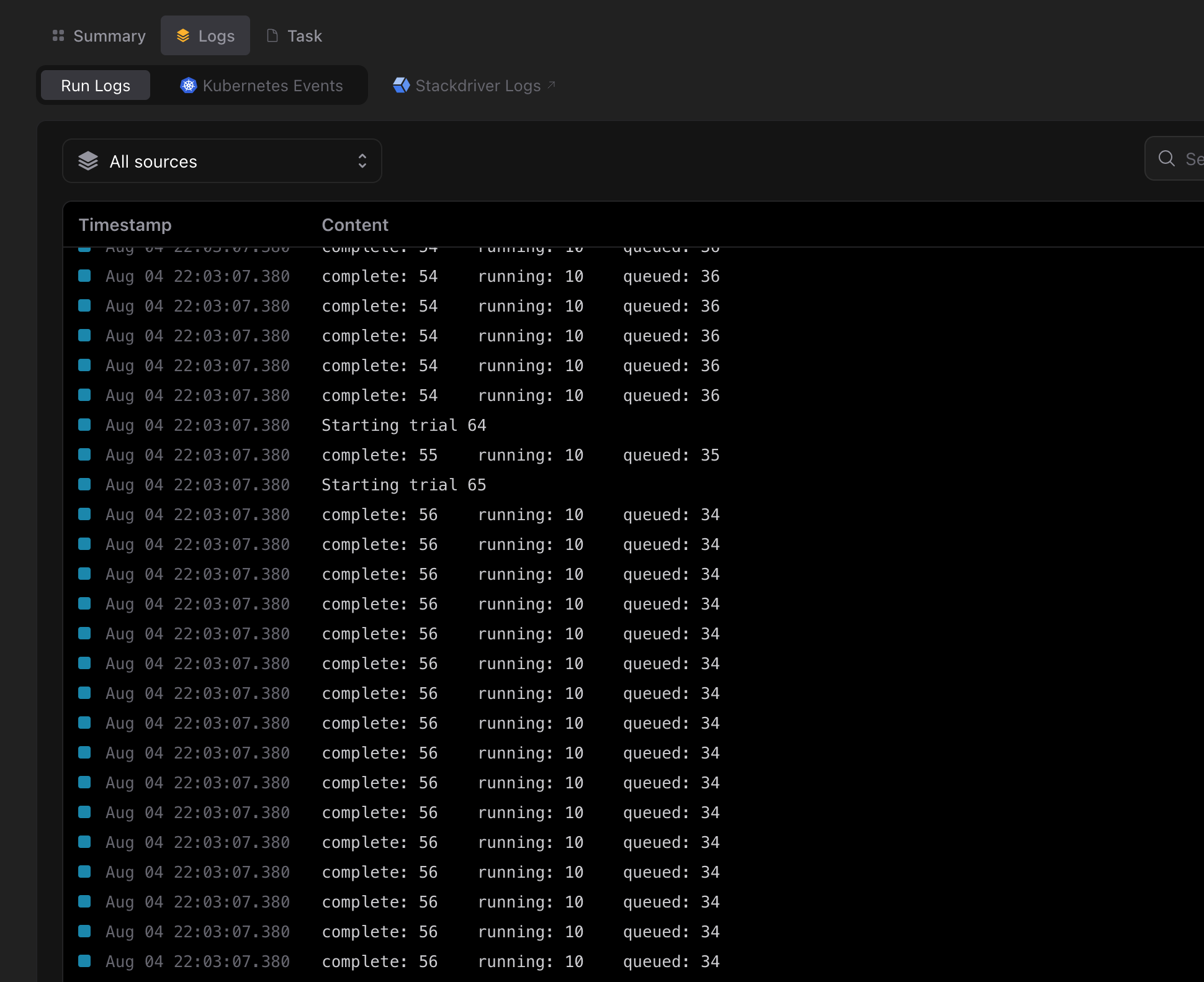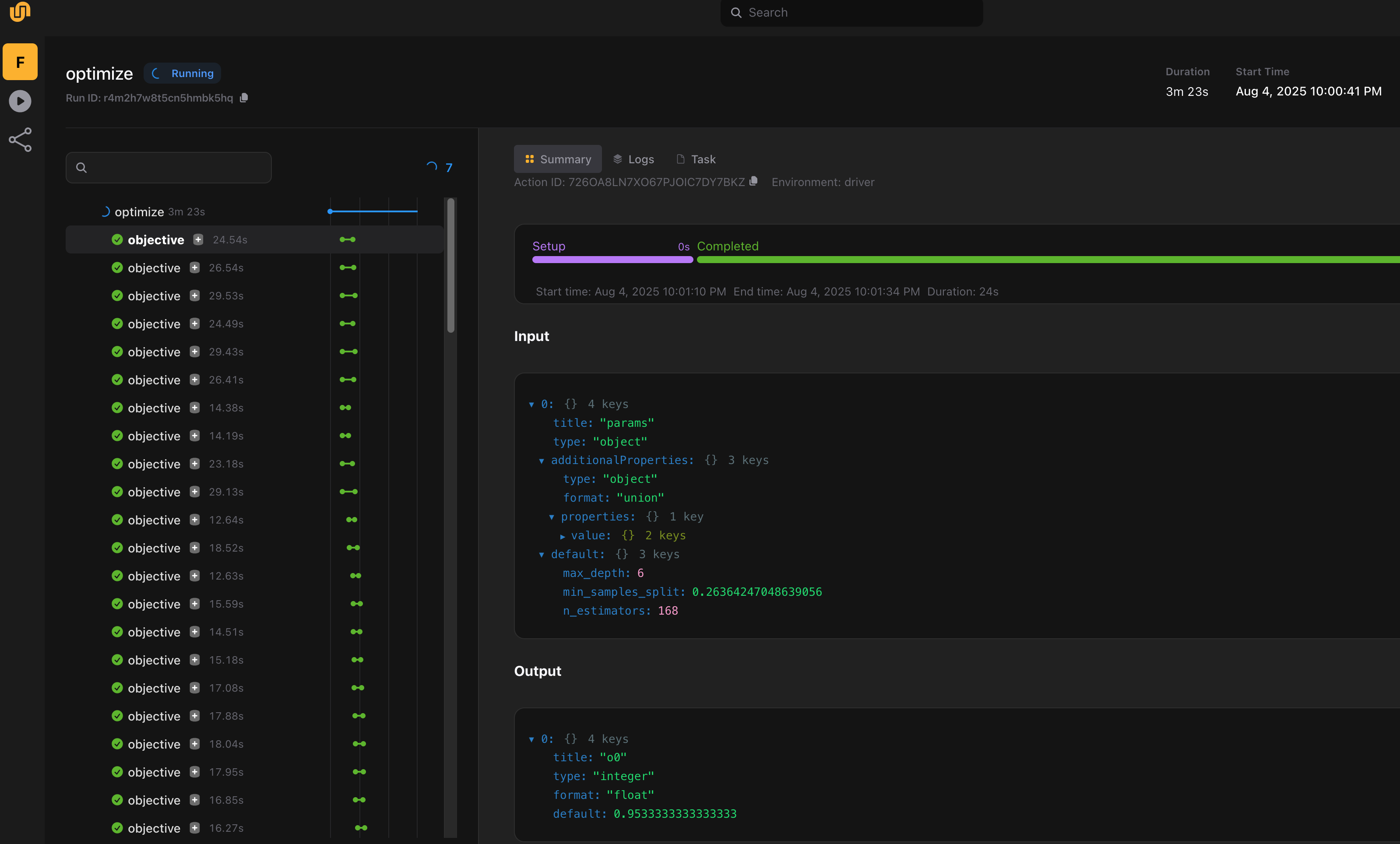Hyperparameter optimization
Code available here.
Hyperparameter Optimization (HPO) is a critical step in the machine learning (ML) lifecycle. Hyperparameters are the knobs and dials of a model—values such as learning rates, tree depths, or dropout rates that significantly impact performance but cannot be learned during training. Instead, we must select them manually or optimize them through guided search.
Model developers often enjoy the flexibility of choosing from a wide variety of model types, whether gradient boosted machines (GBMs), generalized linear models (GLMs), deep learning architectures, or dozens of others. A common challenge across all these options is the need to systematically explore model performance across hyperparameter configurations tailored to the specific dataset and task.
Thankfully, this exploration can be automated. Frameworks like Optuna, Hyperopt, and Ray Tune use advanced sampling algorithms to efficiently search the hyperparameter space and identify optimal configurations. HPO may be executed in two distinct ways:
- Serial HPO runs one trial at a time, which is easy to set up but can be painfully slow.
- Parallel HPO distributes trials across multiple processes. It typically follows a pattern with two parameters: N, the total number of trials to run, and C, the maximum number of trials that can run concurrently. Trials are executed asynchronously, and new ones are scheduled based on the results and status of completed or in-progress ones.
However, parallel HPO introduces a new complexity: the need for a centralized state that tracks:
- All past trials (successes and failures)
- All ongoing trials
This state is essential so that the optimization algorithm can make informed decisions about which hyperparameters to try next.
A better way to run HPO
This is where Flyte shines.
- There’s no need to manage a separate centralized database for state tracking, as every objective run is cached, recorded, and recoverable via Flyte’s execution engine.
- The entire HPO process is observable in the UI with full lineage and metadata for each trial.
- Each objective is seeded for reproducibility, enabling deterministic trial results.
- If the main optimization task crashes or is terminated, Flyte can resume from the last successful or failed trial, making the experiment highly fault-tolerant.
- Trial functions can be strongly typed, enabling rich, flexible hyperparameter spaces while maintaining strict type safety across trials.
In this example, we combine Flyte with Optuna to optimize a RandomForestClassifier on the Iris dataset. Each trial runs in an isolated task, and the optimization process is orchestrated asynchronously, with Flyte handling the underlying scheduling, retries, and caching.
Declare dependencies
We start by declaring a Python environment using Python 3.13 and specifying our runtime dependencies.
# /// script
requires-python = "==3.13"
dependencies = [
"optuna>=4.0.0,<5.0.0",
"flyte>=2.0.0b0",
"scikit-learn==1.7.0",
]
# ///With the environment defined, we begin by importing standard library and third-party modules necessary for both the ML task and distributed execution.
import asyncio
import typing
from collections import Counter
from typing import Optional, Union
These standard library imports are essential for asynchronous execution (asyncio), type annotations (typing, Optional, Union), and aggregating trial state counts (Counter).
import optuna
from optuna import Trial
from sklearn.datasets import load_iris
from sklearn.ensemble import RandomForestClassifier
from sklearn.model_selection import cross_val_score
from sklearn.utils import shuffle
We use Optuna for hyperparameter optimization and several utilities from scikit-learn to prepare data (load_iris), define the model (RandomForestClassifier), evaluate it (cross_val_score), and shuffle the dataset for randomness (shuffle).
import flyte
import flyte.errors
Flyte is our orchestration framework. We use it to define tasks, manage resources, and recover from execution errors.
Define the task environment
We define a Flyte task environment called driver, which encapsulates metadata, compute resources, the container image context needed for remote execution, and caching behavior.
driver = flyte.TaskEnvironment(
name="driver",
resources=flyte.Resources(cpu=1, memory="250Mi"),
image=flyte.Image.from_uv_script(__file__, name="optimizer"),
cache="auto",
)
This environment specifies that the tasks will run with 1 CPU and 250Mi of memory, the image is built using the current script (__file__), and caching is enabled.
Define the optimizer
Next, we define an Optimizer class that handles parallel execution of Optuna trials using async coroutines. This class abstracts the full optimization loop and supports concurrent trial execution with live logging.
class Optimizer:
def __init__(
self,
objective: callable,
n_trials: int,
concurrency: int = 1,
delay: float = 0.1,
study: Optional[optuna.Study] = None,
log_delay: float = 0.1,
):
self.n_trials: int = n_trials
self.concurrency: int = concurrency
self.objective: typing.Callable = objective
self.delay: float = delay
self.log_delay = log_delay
self.study = study if study else optuna.create_study()
We pass the objective function, number of trials to run (n_trials), and maximum parallel trials (concurrency). The optional delay throttles execution between trials, while log_delay controls how often logging runs. If no existing Optuna Study is provided, a new one is created automatically.
async def log(self):
while True:
await asyncio.sleep(self.log_delay)
counter = Counter()
for trial in self.study.trials:
counter[trial.state.name.lower()] += 1
counts = dict(counter, queued=self.n_trials - len(self))
# print items in dictionary in a readable format
formatted = [f"{name}: {count}" for name, count in counts.items()]
print(f"{' '.join(formatted)}")
This method periodically prints the number of trials in each state (e.g., running, complete, fail). It keeps users informed of ongoing optimization progress and is invoked as a background task when logging is enabled.
 Logs are streamed live as the execution progresses.
Logs are streamed live as the execution progresses.
async def spawn(self, semaphore: asyncio.Semaphore):
async with semaphore:
trial: Trial = self.study.ask()
try:
print("Starting trial", trial.number)
params = {
"n_estimators": trial.suggest_int("n_estimators", 10, 200),
"max_depth": trial.suggest_int("max_depth", 2, 20),
"min_samples_split": trial.suggest_float(
"min_samples_split", 0.1, 1.0
),
}
output = await self.objective(params)
self.study.tell(trial, output, state=optuna.trial.TrialState.COMPLETE)
except flyte.errors.RuntimeUserError as e:
print(f"Trial {trial.number} failed: {e}")
self.study.tell(trial, state=optuna.trial.TrialState.FAIL)
await asyncio.sleep(self.delay)
Each call to spawn runs a single Optuna trial. The semaphore ensures that only a fixed number of concurrent trials are active at once, respecting the concurrency parameter. We first ask Optuna for a new trial and generate a parameter dictionary by querying the trial object for suggested hyperparameters. The trial is then evaluated by the objective function. If successful, we mark it as COMPLETE. If the trial fails due to a RuntimeUserError from Flyte, we log and record the failure in the Optuna study.
async def __call__(self):
# create semaphore to manage concurrency
semaphore = asyncio.Semaphore(self.concurrency)
# create list of async trials
trials = [self.spawn(semaphore) for _ in range(self.n_trials)]
logger: Optional[asyncio.Task] = None
if self.log_delay:
logger = asyncio.create_task(self.log())
# await all trials to complete
await asyncio.gather(*trials)
if self.log_delay and logger:
logger.cancel()
try:
await logger
except asyncio.CancelledError:
pass
The __call__ method defines the overall async optimization routine. It creates the semaphore, spawns n_trials coroutines, and optionally starts the background logging task. All trials are awaited with asyncio.gather.
def __len__(self) -> int:
"""Return the number of trials in history."""
return len(self.study.trials)
This method simply allows us to query the number of trials already associated with the study.
Define the objective function
The objective task defines how we evaluate a particular set of hyperparameters. It’s an async task, allowing for caching, tracking, and recoverability across executions.
@driver.task
async def objective(params: dict[str, Union[int, float]]) -> float:
data = load_iris()
X, y = shuffle(data.data, data.target, random_state=42)
clf = RandomForestClassifier(
n_estimators=params["n_estimators"],
max_depth=params["max_depth"],
min_samples_split=params["min_samples_split"],
random_state=42,
n_jobs=-1,
)
# Use cross-validation to evaluate performance
score = cross_val_score(clf, X, y, cv=3, scoring="accuracy").mean()
return score.item()
We use the Iris dataset as a toy classification problem. The input params dictionary contains the trial’s hyperparameters, which we unpack into a RandomForestClassifier. We shuffle the dataset for randomness, and compute a 3-fold cross-validation accuracy.
Define the main optimization loop
The optimize task is the main driver of our optimization experiment. It creates the Optimizer instance and invokes it.
@driver.task
async def optimize(
n_trials: int = 20,
concurrency: int = 5,
delay: float = 0.05,
log_delay: float = 0.1,
) -> dict[str, Union[int, float]]:
optimizer = Optimizer(
objective=objective,
n_trials=n_trials,
concurrency=concurrency,
delay=delay,
log_delay=log_delay,
study=optuna.create_study(
direction="maximize", sampler=optuna.samplers.TPESampler(seed=42)
),
)
await optimizer()
best = optimizer.study.best_trial
print("✅ Best Trial")
print(" Number :", best.number)
print(" Params :", best.params)
print(" Score :", best.value)
return best.params
We configure a TPESampler for Optuna and seed it for determinism. After running all trials, we extract the best-performing trial and print its parameters and score. Returning the best params allows downstream tasks or clients to use the tuned model.
Run the experiment
Finally, we include an executable entry point to run this optimization using flyte.run.
if __name__ == "__main__":
flyte.init_from_config()
run = flyte.run(optimize, 100, 10)
print(run.url)
run.wait()
We load Flyte config from config.yaml, launch the optimize task with 100 trials and concurrency of 10, and print a link to view the execution in the Flyte UI.
 Each objective run is cached, recorded, and recoverable. With concurrency set to 10, only 10 trials execute in parallel at any given time.
Each objective run is cached, recorded, and recoverable. With concurrency set to 10, only 10 trials execute in parallel at any given time.